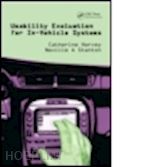Ergonomics often seems to be involved too late in commercial project development processes to have substantive impact on design and usability. However, in the automotive industry, and specifically in relation to In-Vehicle Information Systems (IVIS), a lack of attention to usability can not only lead to poor customer satisfaction, it can also present a significant risk to safe and efficient driving.Usability Evaluation for In-Vehicle Systems describes how to apply a range of usability evaluation methods for IVIS. The authors explore the driving context and the range of driver-IVIS interactions, using case studies that show how Ergonomics methods can add considerable value throughout the product development process. They emphasize practical approaches that can be used to predict and analyze driver behavior with IVIS. The authors also present validation evidence for the methods covered.The book has three key objectives: Define and understand usability in the context of IVIS. This guides the specification of criteria against which usability can be successfully evaluated. Develop a multi-method framework to support designers in the evaluation of IVIS usability. The underlying motivations for the framework are a need for early-stage evaluation to support proactive redesign and a practical and realistic approach which can be used successfully by automotive manufacturers.Develop an analytic usability evaluation method which enables useful predictions of task interaction, whilst accounting for the specific context-of-use of IVIS. The major challenge of this particular context-of-use is the dual-task environment created by interacting with secondary tasks via an IVIS at the same time as driving. Written for students, researchers, designers, and engineers, the book is not only a guide to the practical application of evaluation methods, it also presents important th











